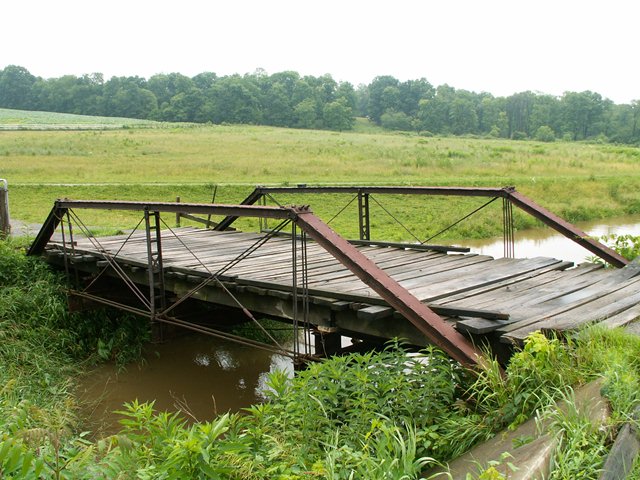We Recommend:
Bach Steel - Experts at historic truss bridge restoration.
BridgeHunter.com Phase 1 is released to the public! - Visit Now
Little Yellow Creek Private Bridge

Primary Photographer(s): Nathan Holth
Bridge Documented: July 4, 2006
Rural: Columbiana County, Ohio: United States
By Builder/Contractor: Unknown
Not Available or Not Applicable
Not Available
Not Available
Not Available
1 Main Span(s)
15XXXX1

View Information About HSR Ratings
Bridge Documentation
With metal truss bridges, sometimes good things come in small packages, and such is the case with this little driveway bridge. This is a very short four panel pin connected Pratt truss bridge with counter diagonals in each panel.
This bridge has the appearance of a very old bridge because of its unusual, non-standard details and its lightweight construction. The top chord connections at the hip vertical have a threaded rod with nut connection type with cast iron fittings in this area as well. This is similar to a design the Wrought Iron Bridge Company used on many of its pony trusses. However, the exact design of the castings as well as the fact that the hip vertical in addition to the diagonal member has the threaded rod with nut detail is unlike the usual Wrought Iron Bridge Company design. This, combined with other unusual detail unlike most Wrought Iron Bridge Company bridges leave it questionable at best that the Wrought Iron Bridge Company built this bridge. The vertical member in the center of the bridge is built up unusually, with a single lattice element in the center, and battens on the rest of it.
This bridge is on a private drive, but is right next to the public road, and you can easily view the bridge and shoot photos from the road. Hopefully whoever owns this bridge realizes what a treasure they have.
Information and Findings From Ohio's Historic Bridge InventorySetting/Context The bridge carries a private farm lane over a stream in a setting of active farms. Physical Description The lightly built, 1-span, pin-connected Pratt pony truss bridge is supported on stone abutments. The upper chords are built-up of toe-out channels with cover plate and battens. There are cast-iron connecting pieces at the end posts. The diagonals in the end panels pass through the upper chord and are bolt connected at the connecting pieces. The center-panel vertical is built-up of angles with battens, but the verticals (floorbeam hangers) in the end panels are four rods that pass through the flanges of the built-up floorbeams, which are hung below the lower chord. The lower chord eyebars bypass the end panel hangers and are held in place by cast-iron guides. Integrity Very heavily rusted. Summary of Significance The pin-connected pony truss bridge, which is dated
ca. 1878 based on style, is technologically significant due to its age
and non-standard details, particularly the connection details at the
upper chords-end posts and the end panel hangers (Criterion C). The
bridge is tentatively attributed to the Wrought Iron Bridge Co. (WIBCo)
based on the connection details, but these details differ slightly from
the larger connecting pieces and built-up hangers found with other
documented examples in the study. The design is described as "very
popular" and having been built widely in an 1881 WIBCo catalogue. It is
1 of 13 very similar examples dating from 1874 to the early 1890s. Justification The bridge is one of over 150 extant pin-connected truss bridges dating from 1874 for pony trusses and 1876 for thru trusses. Twenty six predate 1888 and represent the era of experimentation that evolved into standardized designs by about 1888. This example has moderate significance because the genre and the fabricator are so well represented in Ohio. Bridge Considered Historic By Survey: Yes |
![]()
Photo Galleries and Videos: Little Yellow Creek Private Bridge
Bridge Photo-Documentation
Original / Full Size PhotosA collection of overview and detail photos. This gallery offers photos in the highest available resolution and file size in a touch-friendly popup viewer.
Alternatively, Browse Without Using Viewer
![]()
Bridge Photo-Documentation
Mobile Optimized PhotosA collection of overview and detail photos. This gallery features data-friendly, fast-loading photos in a touch-friendly popup viewer.
Alternatively, Browse Without Using Viewer
![]()
Maps and Links: Little Yellow Creek Private Bridge
This bridge is on a private drive, but is right next to the public road.
Coordinates (Latitude, Longitude):
Search For Additional Bridge Listings:
Bridgehunter.com: View listed bridges within 0.5 miles (0.8 kilometers) of this bridge.
Bridgehunter.com: View listed bridges within 10 miles (16 kilometers) of this bridge.
Additional Maps:
Google Streetview (If Available)
GeoHack (Additional Links and Coordinates)
Apple Maps (Via DuckDuckGo Search)
Apple Maps (Apple devices only)
Android: Open Location In Your Map or GPS App
Flickr Gallery (Find Nearby Photos)
Wikimedia Commons (Find Nearby Photos)
Directions Via Sygic For Android
Directions Via Sygic For iOS and Android Dolphin Browser
USGS National Map (United States Only)
Historical USGS Topo Maps (United States Only)
Historic Aerials (United States Only)
CalTopo Maps (United States Only)

